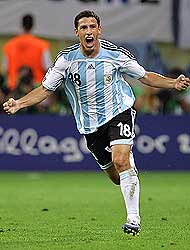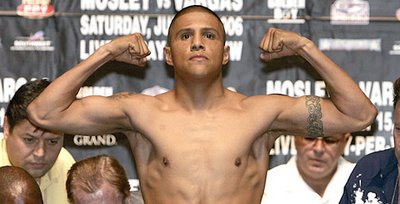With the 2006 World Cup now on the record books, it is time to ask what happened to the Latin Americans?
LACK OF CONVICTION IN THE YOUTHIn a way, both South American powerhouses
Brazil and
Argentina did not win because history and soil were not in their favor:
- Only once in history has a South American nation won the World Cup tournament in European soil. Brazil won its first title back in 1958 in Sweden.
- Individual rivalries weigh heavily and Brazil was coming off a loss against France in the final of 1998 World Cup while Argentina had a dead even all-time record of 2 wins and 2 losses against Germany.
Beyond history and soil, Brazil never reached the level of play the world expected starting with Ronaldinho who never seemed to get into "The Zone" and produce the magic we all have witnessed both with the national team and Barcelona.
In addition, unlike old as fine wine veteran Zinedine Zidane, Brazil's "Golden Oldies" Cafu, Roberto Carlos and Emerson underdelivered and showed they are burned out. Cafu in particular played mechanically and aimlessly. Head coach Carlos Alberto Parreira could not bring himself to select the new generation of exciting, dynamic and creative defenders in the lineup such as Cicinho, Gilberto and Luisao over the tested but depleted familiar names.
As well as Ronaldo played, it was hard to see lethal striker Adriano in the bench as head coach Carlos Alberto Parreira decided that both players could not play together. True, Ronaldo displayed moments of brilliance but he also disappeared from several matches.
Ronaldo did make history scoring 3 goals that bolted him to the top of the World Cup's all-time scorer list with 15 goals surpassing the mark of Gerd Muller of Germany.
Argentina did well but it perished as a result of several factors, but chief among them was the the absence of true conviction and faith in their two young phenoms Carlos
"El Apache" Tevez and Lionel Messi. Head coach Jose Pekerman leaned too heavily on Hernan Crespo, Javier Saviola and most disturbingly on Julio Cruz over his two younger phenoms.

Crespo and Saviola did well, but Cruz and not primed for prome time youngster, Rodrigo Palacio, were non factors.
Hard to accept defeat when the top players don't get top minutes.
On the bright side,
Maxi Rodriguez (pictured above), provided fireworks scoring the best goal of the tournament: a wildly accurate and powerful left-footed volley struck after a masterful reception of the ball with his chest that led to a victory for Argentina over Mexico in the quarterfinals.
Maxi matched Ronaldo and fellow Argentinean teammate Hernan Crespo as the leading Latin American scorers in the tournament with 3 goals each (Crespo was awarded a questionable goal against Mexico that replays show was an own-goal).
Unforgettable moments for the
Albicelestes include their 6-0 trashing of Serbia-Montenegro with a festival world class goals, including a creative passing gem finished of by Esteban Cambiasso.
Ecuador did fine in relation to their expectations. They got out their group and battled England in the quarterfinals gallantly falling by a one goal margin. The team shined in group play highlighted by their impressive win over Poland, 2-0 and crushing of Costa Rica, 3-0. Not surprisingly, they got crushed by Germany, 0-3 in their last group match.
Mexico advanced to the quarterfinals and mildly disappointed falling to the Argentineans in extra time and as a result of a once in a lifetime goal scored by Rodriguez. The
"Aztecas" were solid but unspectacular and never really looked as legitimate contenders for the title.
Paraguay played like Paraguay: hard-working, plodding, determined, with limited imagination, creativity and pizzaz. Paraguay is the "Latin American construction worker soccer team." Give them a few bricks and they will build a house. Effective but hardly worth watching. With their dogged determination the
"Guarani" team managed one two narrow one-goal losses against England and Sweden and a late meaningless win over Trinidad & Tobago.
Costa Rica is the complete opposite of Paraguay. Costa Rica is the "Latin American floral designer soccer team." Give them a few flowers and they will put together a beautiful bouquet. Unfortunately, their bouquet always gets properly stomped on by a team with a more reasonable balance between beauty and efficiency, between artistry and pragmatism. This time all their opponents crushed their bouquets no matter how artistically and creatively they had been put together. The
"Ticos" lost all three of their matches.
Zinedine Zidane rightly earned the FIFA Golden Ball award as best overall player in the tournament. Moreover, only two Latino players were selected to the Mastercard All Star Team, the "Dream Team" as determined by the FIFA Technical Study Group.
The Mastercard All Star Team is as follows:
Goalkeepers
Gianluigi Buffon (Italy), Jens Lehmann (Germany), Ricardo (Portugal)
Defenders
Roberto Ayala (Argentina), John Terry (England), Lilian Thuram (France), Philipp Lahm (Germany), Fabio Cannavaro (Italy), Gianluca Zambrotta (Italy), Ricardo Carvalho (Portugal)
Midfielders
Ze Roberto (Brazil), Patrick Vieira (France), Zinedine Zidane (France), Michael Ballack (Germany), Andrea Pirlo (Italy), Gennaro Gattuso (Italy), Francesco Totti (Italy), Luis Figo (Portugal), Maniche (Portugal)
Forwards
Hernan Crespo (Argentina), Thierry Henry (France), Miroslav Klose (Germany), Luca Toni (Italy)
- CGG -
###
 Latino Sports Journal is sponsored by Verizon Wireless.
Latino Sports Journal is sponsored by Verizon Wireless.





